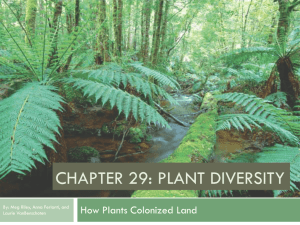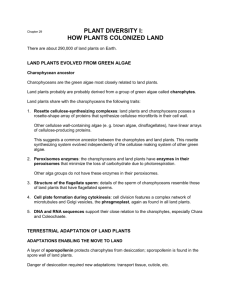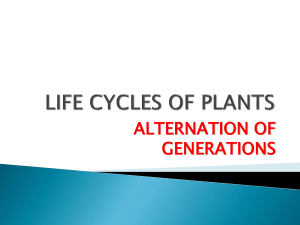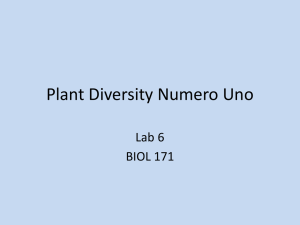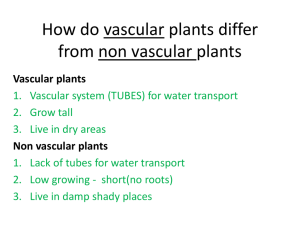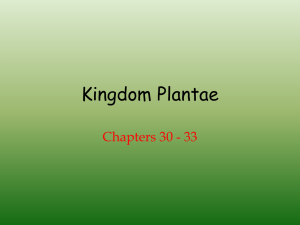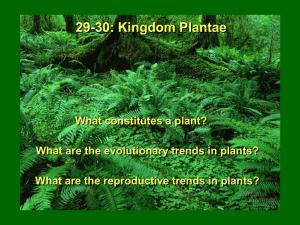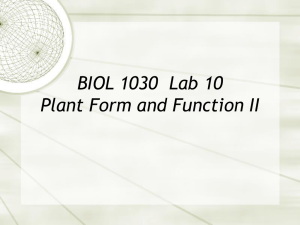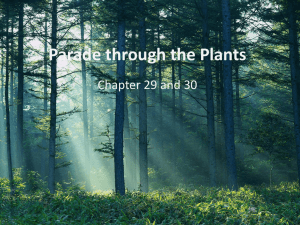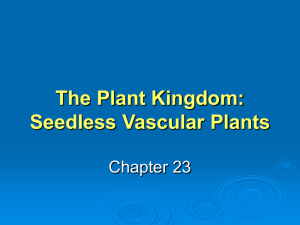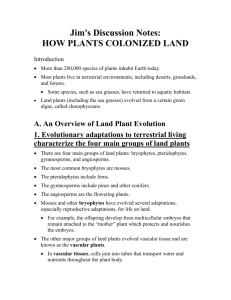29 Origin of Plants
advertisement
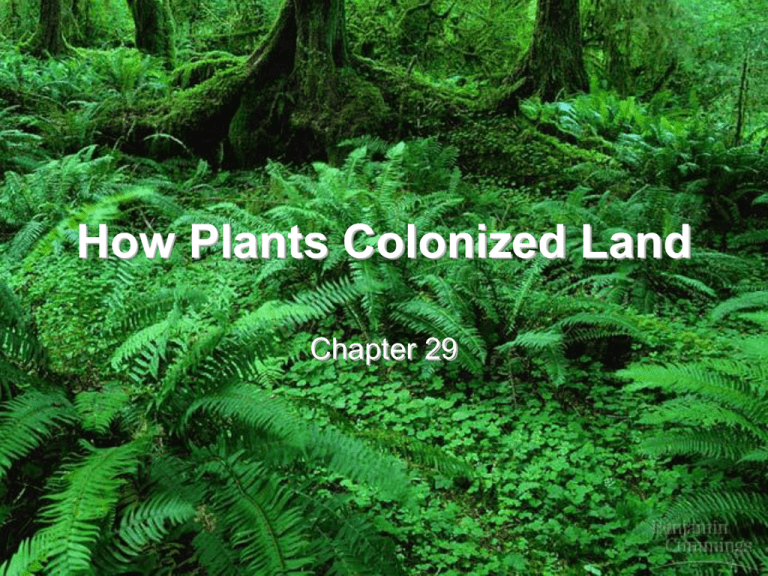
How Plants Colonized Land Chapter 29 Overview: • Origins of Mulitcellularity • Quick look at over all diversity in Plant Kingdom • Characteristics of Plants – Special features, structures • Origin from green algae – Link to Charophyceans – Evidence to support – Dates • Alternation of generations – Origin of embryophytes • Bryophyte (moss) lifecycle – in Lab • Pteridophyte (fern) lifecycle – in Lab Multicellularity • • • • • Arose independently several times in Eukarya Caused another new wave in evolution Origins in simpler colonial forms – Volvox Cellular specialization and Division of labor Escape cell size limitations – Membrane area to cytoplasm volume ratio • Multicellularity solves ratio limits Fig 6.7 The Plant Kingdom • • • • Origins over 475 MYA 10 Divisions 4 Basic lifecycles Green algae that evolved onto land • Evolved becoming more terrestrial, independent from water • Then coevolved with pollinators, dispersal • An overview of land plant evolution Land plants Vascular plants Figure 29.7 Angiosperms Origin of seed plants (about 360 mya) Origin of vascular plants (about 420 mya) Origin of land plants (about 475 mya) Ancestral green alga Seed plants Gymnosperms Pterophyte (ferns, horsetails, whisk fern) Seedless vascular plants Lycophytes (club mosses, spike mosses, quillworts) Mosses Hornworts Liverworts Charophyceans Bryophytes (nonvascular plants) Major events: • • • • Living on land, spores Vascular tissues Pollen, Seeds Flowers & Fruits The Plant Kingdom? Who is in / out? Viridiplantae Streptophyta Plantae Red algae Chlorophytes Ancestral alga Charophyceans Embryophytes • We’ll see all but the hornworts in lab Table 29.1 Evolutionary Sequence • Green Algae (Charophyceans) gave rise to: • Mosses (475 MYA) and liverworts, which gave rise to: • Ferns (420 MYA) and related plant groups which gave rise to: • Gymnosperms (360 MYA) Conifers and related plant groups which gave rise to: • Angiosperms (140 MYA) (flowering plants) which have form two groups: – Monocots – Eudicots Charophyceans- plant’s green algae ancestor Chara Coleochaete Modern examples of charophyceans Original Traits • Found in ancestral species and new species Derived Traits • Not found in ancestral species, new to daughter species Older terms: primitive and advanced traits What’s new in Plants: Some Derived Characteristics of Plants • • • • • • • • Growth by divisions in Apical Meristems Multicellular dependent embryos Alternation of generations Spores Multicellular gametangia Cuticle Transport tissues Secondary compounds Growth by cell divisions in Apical Meristems • Localized regions of cell division • In shoot tips, roots Multicellular dependent diploid embryos • Land plants are called embryophytes • Haploid charophyceans Spores • Walls of resistant sporopollenin • Dry out and travel in the wind • Zygotes of Charophyceans protected by sporopollenin – precursor to spore walls? • Disperse then grow into gametophyte plants Multicellular gametangia Archegonia Make egg at base of Vase like column Antheridia produce many sperm cells that swim to egg All haploid tissues, gametes form by mitosis Cuticle • Waxy covering layer prevents water loss, and microbial attack • Stomata allow for gas exchange • Thicker layers in plants adapted to arid conditions Transport tissues • Xylem carries water up from the roots to the leaves • Phloem carries a sugary solution through out the plant Secondary Compounds • Metabolic side branches off common pathways • Provide benefit to plant ( defense, etc.) • Can be used by People as Flavorings, drugs insecticides, etc. APICAL MERISTEMS Apical meristem of shoot Developing leaves Apical meristems of plant shoots and roots. The light micrographs are longitudinal sections at the tips of a shoot and root. Apical meristem of root Shoot Root 100 µm 100 µm Haploid multicellular organism (gametophyte) Mitosis Mitosis n n n ALTERNATION OF GENERATIONS Spores n n Gametes MEIOSIS FERTILIZATION 2n 2n Zygote Mitosis Diploid multicellular organism (sporophyte) Alternation of generations: a generalized scheme WALLED SPORES PRODUCED IN SPORANGIA Spores Sporangium Longitudinal section of Sphagnum sporangium (LM) Sporophyte Gametophyte Sporophyte and sporangium of Sphagnum (a moss) MULTICELLULAR GAMETANGIA Female gametophyte Archegonium with egg Antheridium with sperm Archegonia and antheridia of Marchantia (a liverwort) Male gametophyte MULTICELLULAR, DEPENDENT EMBRYOS Embryo Maternal tissue 2 µm Embryo and placental transfer cell of Marchantia 10 µm Wall ingrowths Placental transfer cell Origin of plants • How did the sporophyte generation come about? • Preadaptations may have lead the charyophyceans onto land Hypothesis for origin of alternation of generations • Delayed meiosis maximizes output of sexual reproduction. – More spores can be produced per fertilization event • Adapting to drying conditions with fewer surviving spores • Lineages separate before sporophytes evolved much Preadaptation • Evolutionary adaptation that was selected for under one set of conditions • This trait then gives an advantage for a new situation with different conditions. Preadaptation • Evolutionary adaptation that was selected for under one set of conditions • This trait then gives an advantage for a new situation with different conditions. Feathers arose first for insulation, then helped with flight Adaptation to shallow waters preadapted Charophyceans to life on land • Adapted to periodic drying during low tides, droughts – Leads to cuticle? • Adapted to higher light intensities – Leads to common chloroplast structure? • Zygote protected from drought within archegonia with a layer of sporopollenin – Leads to spore wall? Alternation of Generations • Separate multicellular haploid and diploid phases – (2n) Sporophyte make spores by meiosis – (n) Gametophyte makes gametes by mitosis • Sperm and egg (moss & fern) • Pollen and Ovule (gymnosperm & angiosperm) • The sporophyte and gametophyte are very different in morphology – Vascular tissues only appear in sporophyte phase • Sporophyte becomes more dominant in new plant groups • Charophyceans lack sporophyte phase Charophycean life cycle Characteristics that Plants share with the green algae group Charophyceans • Autotrophic Multicellular Eukaryote • Have cell walls made of cellulose – Made by rosette cellulose-synthesizing complexes – 20-26% of wall material, closest match in algae • Chloroplast similarities – have chlorophyll a & b, use β-carotene as accessory – Thylakoids stacked in grana – Chloroplast DNA comparisons • • • • • Peroxisome enzymes Cell plate formation by phragmoplast Nuclear membrane breaks down during mitosis Sperm ultrastructure - biflagellate Gene sequences – rRNA, Cytoskeleton proteins Switch to sporophyte dominance Figure 29.13 Hypotheses for the evolution of leaves Vascular tissue (a) Microphylls, such as those of lycophytes, may have originated as small stem outgrowths supported by single, unbranched strands of vascular tissue. (b) Megaphylls, which have branched vascular systems, may have evolved by the fusion of branched stems. What’s new in Mosses? • • • • • Spores / sporangia Sporophyte phase Upright growth on land Cuticle Multicellular gametangia The Bryophytes • Bryophytes are represented by three divisions: – Division Hepatophyta - liverworts – Division Anthocerophyta - hornworts – Division Bryophyta – mosses Liverworts and hornworts are believed to be more similar to what early plants were like. Bryophyte lifecycle: moss • Haploid dominant • No vascular tissues • Filamentous protonema stage • Swimming sperm • Disperse by spores • Dependent sporophyte • Dioecious gametophytes • No true leaves • Rhizoids, not roots What’s new in Ferns? • • • • Vascular tissue True roots and stems and leaves Stomata Sporophyte (2n) dominate Pteridophytes evolved over 400 MYA Seedless, Vascular plants (having Xylem & Phloem). Today represented by two divisions: Pterophyta: Ferns, Horsetails (Equisetum) Lycophyta: Club moss Cooksonia, an extinct plant over 400 million years old, is the earliest known vascular plant. The branched sporophytes were up to 50cm tall with small lignified cells, much like the xylem cells of modern pteridophytes. Vascular tissue • Allows plants to grow taller • More support by lignified xylem tracheids • Can pull water up from soil – Can tolerate soil that is drier on the surface • Form parts of true leaves and roots. • Only found in diploid tissue – Lead to sporophyte dominance? Fern Lifecycle • Diploid dominate • Gametophyte still independent, short lived, – monoecious in fern (Pteridophyta) – dioecious in club moss (Lycophyta) • Sporophyte – in Lycophyta is Monecious – in Pteridiophyta is Dioecious • Spores disperse plant • Sporophyte perennial, monoecious Figure 29.23 The life cycle of a fern LYCOPHYTES (PHYLUM LYCOPHYTA) Strobili (clusters of sporophylls) Isoetes gunnii, a quillwort Selaginella apoda, a spike moss Diphasiastrum tristachyum, a club moss Psilotum nudum, a whisk fern PTEROPHYTES (PHYLUM PTEROPHYTA) Equisetum arvense, field horsetail Vegetative stem Athyrium filix-femina, lady fern Strobilus on fertile stem WHISK FERNS AND RELATIVES HORSETAILS FERNS Carboniferous forest based on fossil evidence
